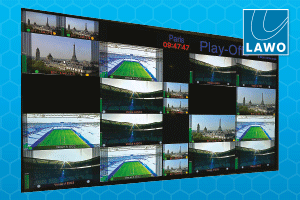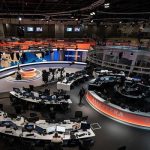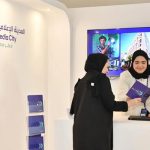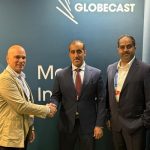The end-to-end broadcast infrastructure at the Al Jazeera studios in Doha is being revamped as part of the much talked-about Al Jazeera Workplace Transformation Project. Vibhuti Arora finds out more about the audio transformation at seven of the network’s studios As part of the Al Jazeera Workplace Transformation Project, the entire infrastructure at Al Jazeera’s […]
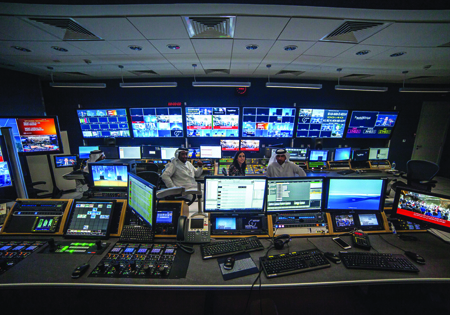 The end-to-end broadcast infrastructure at the Al Jazeera studios in Doha is being revamped as part of the much talked-about Al Jazeera Workplace Transformation Project. Vibhuti Arora finds out more about the audio transformation at seven of the network’s studios
The end-to-end broadcast infrastructure at the Al Jazeera studios in Doha is being revamped as part of the much talked-about Al Jazeera Workplace Transformation Project. Vibhuti Arora finds out more about the audio transformation at seven of the network’s studios
As part of the Al Jazeera Workplace Transformation Project, the entire infrastructure at Al Jazeera’s existing studios in Doha is being revamped. This covers cameras, vision mixers, audio control, editing facilities, post-production, MCR, transmission and ingest, which are some of the areas that have been renewed in the studio. In the two new studios and five existing ones, the audio infrastructure has also been built from scratch to include the latest solutions, to deliver the best audio quality and also future-proof them for any broadcast audio requirements.
Syed Yusuf Abdulla, Acting Solution Architect Broadcast, Technology Solution and Integration at Al Jazeera Media Network, says that building the digital audio infrastructure in both the revamped and new studios involved extensive networking and robust fibre connectivity.
Even for the upgrade of the existing studios, it was only the studio area which was used, but in terms of equipment and engineering design, everything was built from the ground up. Before the upgrade, some studios were fitted with digital concepts while others had analogue, but now all of our studios across the network are being fitted with the same equipment that can be interlinked.
Detailed planning went into drawing up the requirements for what was needed in all areas, says Abdulla. A highlight of this project is that it is completely based on digital audio, which means the entire network was revamped to make room for new workflows and solutions. The connectivity is over fibre now and connects all points in a seamless way.
As with all sections, the audio is integral to the studios. Allie Kader Gaffoor, Network Specialist Sound & Audio Acoustics Network Operations Standards, explains how the audio infrastructure is being deployed in the new and existing studios.
We decided to go with Calrec, because we found it to be the best fit for our audio requirements both operationally as well as technically. TSL provided the audio metering solution and Genelec speakers have been deployed for audio monitoring. The music playback is on a SpotOn system, while Riedel provided the communications/talkback systems. We opted for a Sennheiser microphone D9000 series, the first deployment of the system in the region, as well as the Sennheiser IEM system.
Due to the digital element and the interconnection of the equipment, a detailed connectivity plan was designed by the engineering team, led by Abdullah. Thanks to the digital interconnectivity of this equipment, communication between all the connections is easier and faster because the teams now work with file-based information sharing. There was a lot of emphasis on redundancy and interconnection to the back-up systems to make a flawless switch from the main to the back-up.
We chose systems that we knew would give us the optimum level of performance and left little room for error. For example, the Calrec system has a master core that links to the console core, which makes it easier for the operator to access audio from other studios. Likewise, with our Sennheiser D9000 series, this system was carefully designed due to the multi-studios scenario. Our Riedel system spans all our channels and broadcast centres, Gaffoor notes.
Most of these systems only require software upgrades in the future, which makes them very scalable. The new frames for the audio equipment will facilitate any growth required in future by any studio or production needs. As a result, the workflow is more efficient and time-saving and leaves little room for error, making it easier for engineers and operators to trouble-shoot.
Sennheiser was already being used across the network in the five existing studios before the upgrade, and the sound engineering at Al Jazeera decided to continue with the same brand. In order to cater to the growing need for a technical refresh and remain up to date with the latest in the field of audio technology, the Sennheiser systems were replaced with new ones.
We found the brand reliable, and what helped us further was the fact that Sennheiser offered a digital system, which was what we wanted at that point in time. Sennheiser met our needs in terms of microphones as well as IEM [in-ear monitoring], Gaffoor says.
As early as 2013, Sennheiser made us aware of the new D9000 system and EM9046 because we were initially looking at the EM3237 and SK5212 MKII for our microphone solution.
At that time, the Digital 9000 series hadnt yet been released, but it was a better fit for the project. It was to be released later that year but Sennheiser decided to get in touch with some of the project team at Al Jazeera and offer them the system anyway.
A working system of the Digital 9000 series was then sent to Al Jazeeras Doha headquarters for the team to try it out for themselves. The D9000 wireless microphone transmits uncompressed audio, which means it reproduces a quality of audio very close to that of a wired microphone.
For audio processing, Al Jazeera decided on Junger units to ensure balanced audio across the channels.
After some on-air testing, the team decided to change the specifications from the old Sennheiser system to the Digital 9000 series. Sennheiser worked closely with Sony Professional (Sony PSMEA), the systems integrator for the project, to bring it up to speed with the technology and assist in carrying out site surveys. The culmination of these site surveys was a report detailing both Sony and Sennheisers recommendations regarding RF planning for the whole site.
All studios had to be connected to wireless microphones and in-ear monitoring systems, requiring finite radio frequency coordination to ensure that there is no intermodulation or interference between them, even if presenters walk from studio to studio wearing their transmitters.
This meant the antennas had to be placed very carefully so as to not get in each others way.
Because of the coverage areas in some studios, bespoke multi-antenna systems were designed and deployed with the help of Sennheisers Customer Development and Application Engineering team in Germany.
The project has now become the largest broadcast project that Sennheiser has worked on from its Middle East office.
Gaffoor explains that the file-based system workflow is carried out from a centralised file-based location that interfaces with the baseband system. These two systems work hand in hand to ensure information and material is available instantly. The files can be accessed via the MAM and PAM (pluggable authentication module), the central storage system.
SpotOn, a windows-based playout system operated from a PC, plays WAV or mp3 format audio files that are connected to the server, so the material can be shared between studios in the channels locally as well as abroad.
Riedels fibre-based network system gives us complete intercom connectivity locally and with our broadcast centres abroad. VoIP interconnections are available to allow every channel across the network to communicate with other channels.
Our Calrec system uses the Hydra networking. We have a master core that links to console cores to make audio available from the different studios or sections, connected to the MADI. This is available across the network. The Calrec Hydra network is connected to the production router on MADI all studio audio programmes get embedded from the hybrid production router and these studio transmission lines go to our Centralised Channel Transmission.
As for future development capabilities with the Sennheiser system, we can have DANTE protocol as it gives us the infrastructure to have it on the network. For audio post, files transfers are done on the PAM. Editors can send and receive files in Avid Interplay to and from Pro Tools, adds Gaffoor.
The next step
Commenting on the status of the project, Ali El Husseini, Head of Network Operation Standards,
says that the various channels with multiple studios are being upgraded concurrently in Doha.
The focus is on the main news studios to be completed, but the project is being undertaken in phases. It is something that cannot be completed hastily, as once completed, the project needs to meet our requirements exactly so all broadcast centres globally can integrate with Doha.
This also leads to a very challenging work environment, due to multiple sites being upgraded at the same time, some of them 24/7 operations.
Arranging time for work to take place in these studios can pose a challenge, but luckily our team has always managed to overcome whatever challenges have come their way, says El Husseini.


